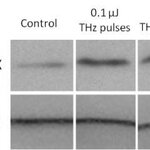Applied Physics

AC, DC: What's The Difference ?
The difference between alternating current (AC) and direct current (DC) is readily explained, yet most widely published "explanations" seem to muddle the facts and cause confusion. I hope that this short article may help to clarify matters a little.
A Little Etymology
Originally, alternating current was called "alternate" current and direct current was called "continuous" current.
In the presence of the existing diversity of opinion regarding the relative merits of the alternate and continuous current systems, great importance is attached to the question…

Computer memory works on the basis of electrons that are moved around and stored. Electrons are small and, when it comes to insuring that information will not be lost over time, can be difficult to control using relatively thick insulator walls, so that information will not be lost over time.
The physics issues limit storage density and cost the system a great deal of energy so researchers pursue nanoelectronic components that make use of ions, i.e. charged atoms, for storing data. Ions are some thousands of times heavier that electrons and are therefore much easier to 'hold down'. In this…

When many of us were kids, water-transfer printing meant a fake tattoo. For our children, it will mean peel-and-stick versions of solar cells that charge cell phones, change the tint on windows, or power their toys.
Peel-and-stick, or water-assisted transfer printing (WTP), technologies were developed by a group at Stanford and have been used before for nanowire based electronics. A new partnership between Stanford University and the U.S. Department of Energy's National Renewable Energy Laboratory (NREL) has conducted the first successful demonstration using actual thin film solar…

Researchers have designed a new kind of adaptive material with tunable transparency and wettability features - imagine a tent that blocks light on a dry and sunny day, and becomes transparent and water-repellent on a dim, rainy day. Or highly precise, self-adjusting contact lenses that also clean themselves.
The new material was inspired by natural dynamic, self-restoring systems, such as the liquid film that coats your eyes - tears. Individual tears join up to form a dynamic liquid film with an obviously significant optical function that maintains clarity, while keeping the eye moist…

An autonomous robotic jellyfish the size and weight of a grown man has been developed.
Nicknamed Cyro, this prototype is a larger model of the robotic jellyfish (named RoboJelly) the same team unveiled in 2012. RoboJelly is roughly the size of a man's hand, typical of jellyfish found along beaches.
Jellyfish are attractive candidates to mimic because of their ability to consume little energy owing to a lower metabolic rate than other marine species. Additionally, they appear in wide variety of sizes, shapes and colors, allowing for several designs. They also inhabit every major oceanic…

A team of Harvard scientists have succeeding in measuring the magnetic charge of single particles of matter and antimatter more accurately, by capturing individual protons and antiprotons in a "trap" created by electric and magnetic fields and precisely measuring the oscillations of each particle.
The researchers were able to measure the magnetism of a proton more than 1,000 times more accurately than an antiproton had been measured before. Similar tests with antiprotons produced a 680-fold increase in accuracy in the size of the magnet in an antiproton.
Making precise…

Terahertz (THz) radiation, in the electromagnetic spectrum between microwaves and infrared light, is rapidly finding important uses in medical diagnostics, security, and scientific research.
But researchers are pursuing answers regarding potential human health risks.
New studies performed on lab-grown human skin suggests that short but powerful bursts of THz radiation increases the production of proteins that help the body fight cancer - but can also
cause DNA damage
. The findings, which are the result of a collaboration between physicists at the University of Alberta…

Wind energy is not very efficient and activists have turned on it because 300,000 out of 10,000,000,000 birds are killed by wind turbines each year. Without subsidies it would not exist but exist it does, only now manufacturers have had to discover physics they did not anticipate.
Wind turbine failures primarily happen because components are weakened under turbulent air flow conditions and then need to be replaced, at significant cost.
A team writing in European Physical Journal B set out to find a method for detecting fatigue in wind turbines parts without having to remove each of the…

Researchers at the Universities of Edinburgh and Southampton have brought the science of repairing broken bones into the 21st century, using adult bone stem cells combined with a degradable lightweight plastic that encourages real bone to re-grow.
Researchers have developed the material with a honeycomb scaffold structure that allows blood to flow through it, enabling stem cells from the patient's bone marrow to attach to the material and grow new bone. Over time, the plastic slowly degrades as the implant is replaced by newly grown bone. They developed the material by blending three…

Feel heavier after the holidays?
Newcastle University says you are not alone. Their Theta-probe XPS machine, the only one of its kind in the world, has shown that the original kilogram is also heavier - at least compared to when it became the metric standard in 1875.
The International Prototype Kilogram (IPK) is the standard against which all other measurements of mass in the metric system are set. Stored in the International Bureau of Weights and Measures in Paris, forty official replicas of the IPK were made in 1884 and distributed around the world in order to standardize mass. The UK…